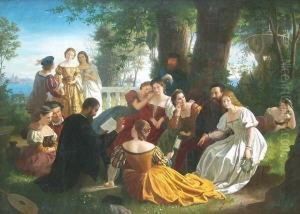Adolf Friedrich G. Wichmann Paintings
Adolf Friedrich Georg Wichmann was a notable German painter born on October 19, 1820, in Berlin, Germany. His contributions to the art world during the 19th century were primarily in the realm of portrait painting, though he also ventured into historical subjects, showcasing a versatile talent that resonated well with the art community of his time. Wichmann's early interest in art led him to pursue formal education in the field, culminating in studies at the Prussian Academy of Arts in Berlin, where he was significantly influenced by the teachings and works of prominent artists of the era.
Throughout his career, Wichmann developed a distinctive style that combined meticulous attention to detail with a profound understanding of his subjects, allowing him to capture more than just the physical likeness but also the essence and personality of those he painted. His portraits were highly sought after by the elite of society, earning him a reputation as a painter of notable proficiency and sensitivity. Despite the fame and recognition he received for his portrait works, Wichmann also dedicated part of his career to exploring historical themes, where he applied the same level of detail and emotional depth to scenes from the past, adding a narrative quality to his paintings that was both engaging and thought-provoking.
Wichmann's contributions to German art were cut short by his untimely death on April 15, 1866, in Berlin. Although his career was relatively brief, his influence persisted, with his works continuing to be appreciated for their technical skill and emotional depth. Today, Wichmann's paintings can be found in various art collections and museums, serving as a testament to his skill and dedication to the craft of painting. His legacy lives on as an example of 19th-century German portraiture and historical painting, reflecting the cultural and artistic vibrancy of his time.

